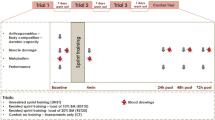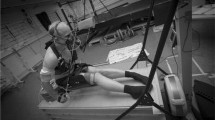Abstract
Six male and ten female physically active students performed 30-s sprint training on a cycle ergometer three times a week for 4 weeks, to investigate the training responses of skeletal muscle and to evaluate possible sex differences in this respect. Three repeated sprint tests with a 20-min rest in between were performed and muscle biopsies from the vastus lateralis muscle were taken before and after the training period. Mean power (average of sprint I–III) and type HB cross-sectional fibre area increased only in the women (7% and 25% respectively) following sprint training, resulting in a decreased sex difference. There was an increase in total lactate dehydrogenase (LD) activity following sprint training in both sexes, although the levels were lower in the women both before and after training. Glycogen content increased and the activity of LD iso-enzyme I decreased in the women, but not in men. It was hypothesised that both the smaller areas of type II fibres and lower activity of LD generally seen in women may be due in part to less frequent activation of type TI fibres in women than in men. If this were the case, the women should respond to sprint training (a type of training that activates type II fibres) to a relatively greater extent than men. That the observed increase in type IIB fibre area in response to sprint training was greater in the women than in men supported the hypothesis of the study. However, the results for LD activity, which showed a similar response in the men and the women, did not support the hypothesis.
Similar content being viewed by others
References
Allemeier CA, Fry AC, Johnson P, Hikida RS, Hagerman FC, Staron RS (1994) Effects of sprint cycle training on human skeletal muscle. J Appl Physiol 77:2385–2390
Andersson B, Xu X, Rebuffé-Scrive M, Terning K, Krotkiewski M, Björntorp P (1991) The effects of exercise training on body composition and metabolism in men and women. Int J Obes 15:75–81
Balsom PD, Ekblom B, Söderlund K, Sjödin B, Hultman E (1993) Creatine supplementation and dynamic high-intensity intermittent exercise. Scand J Med Sci Sports 3:143–149
Bar-Or O, Dotan R, Inbar O, Rothstein A, Karlsson J, Tesch PA (1980) Anaerobic capacity and muscle fibre type distribution in man. Int J Sports Med 1:82–85
Bergström J (1962) Muscle electrolytes in man. Scand J Clin Lab Invest 14 [Suppl 68]:1–110
Bodin K, Esbjörnsson M, Jansson E (1994) Alactic ATP turnover rate during a 30-s cycle sprint in females and males Clin Sci [Suppl] 87:205
Cadefau J, Casademont J, Grau JM, Fernandéz J, Balaguer A, Vernet M, Cussó R, Urbano-Marquez A (1990) Biochemical and histochemical adaptation to sprint training in young athletes. Acta Physiol Scand 140:341–351
Costill DL, Coyle EF, Fink WF, Lesmes GR, Witzman FA (1979) Adaptation in skeletal muscle following strength training. J Appl Physiol 46:96–99
Dotan R, Bar-Or O (1983) Load optimization for the Wingate anaerobic test. Eur J Appl Physiol 51:409–417
Esbjörnsson M, Sylvén C, Holm I, Jansson E (1993) Fast twitch fibres may predict anaerobic performance in both females and males. Int J Sports Med 14:257–263
Esbjörnsson M, Bodin K, Jansson E (1994) Females have lower glycogenolytic rate in type I muscle fibres than males during a 30-s Wingate test. Clin Sci [Suppl] 87:116
Essén B, Jansson E, Henriksson J, Taylor AW, Saltin B (1975) Metabolic characteristics of fibre types in human skeletal muscle. Acta Physiol Scand 95:153–165
Gambert SR, Garthwaite TL, Pontzer CH, Cook EE, Tristani FE, Duthie EH, Martinson DR, Hagen TC, McCarty DJ (1981) Running elevates plasma beta-endorphin immunoreactivity and ACTH in untrained human subjects. Proc Soc Exp Biol Med 168:1–4
Glenmark B, Hedberg G, Jansson E (1992) Change in muscle fibre type from adolescence to adulthood in women and men. Acta Physiol Scand 146:251–259
Gratas-Delamarche A, Le Cam R, Delamarche P, Monnier M, Koubi H (1994) Lactate and catecholamine responses in male and female sprinters during a Wingate test. Eur J Appl Physiol 68:362–366
Green HJ, Fraser IG, Ranney DA (1984) Male and female differences in enzyme activities of energy metabolism in vastus lateralis muscle. J Neurol Sci 65:323–331
Holm SA (1979) A simple sequentially rejective multiple test procedure. Scand J Stat 6:63–70
Jacobs J, Tesch PA, Bar-Or O, Karlsson J, Dotan R (1983) Lactate in human muscle after 10 and 30 s of supramaximal exercise. J Appl Physiol 55:365–367
Jacobs I, Esbjörnsson M, Sylvén C, Holm I, Jansson E (1987) Sprint training effects on muscle myoglobin, enzymes, fibre types and blood lactate. Med Sci Sports Exerc 19:368–374
Jansson E, Hedberg G (1991) Skeletal muscle fibre types in teenagers: relation to physical performance and physical activity. Scand J Med Sci Sports 1:31–44
Jansson E, Esbjörnsson M, Holm I, Jacobs I (1990) Increase in the proportion of fast-twitch muscle fibres by sprint training in males. Acta Physiol Scand 140:359–363
Komi PV, Karlsson J (1978) Skeletal muscle fibre types, enzyme activities and physical performance in young males and females. Acta Physiol Scand 103:210–218
Lin L, Sotonyi P, Somogyi E, Karlsson J, Folkers K, Nara Y, Sylvén C, Kaijser L, Jansson E (1988) Coenzyme Q10 content in different parts of the normal heart. Clin Physiol 8:391–398
Lin L, Sylvén C, Sotonyi P, Somogyi E, Kaijser L, Jansson E (1989) Lactate dehydrogenase and its isoenzyme activities in different parts of the normal human heart. Cardiovasc Res 23:601–606
Linossier M-T, Denis C, Dormois D, Geyssant A, Lacour JR (1993) Ergometric and metabolic adaptation to a 5-s sprint training programme. Eur J Appl Physiol 67:408–414
Lowry C, Kimmey J, Fleder S, Chi M, Kaiser K, Passonneau P, Kirk K, Lowry O (1978) Enzyme patterns in single human muscle fibres. J Biol Chem 253:8269–8277
Lowry OH, Passonneau JV (1972) A flexible system of enzymatic analysis. Academic Press, New York
Novikoff AB, Shin W, Drucker J (1961) Mitochondrial localization of enzymes: staining results with two tetrazolium salts. J Biophys Biochem Cytol 9:47–61
Nygaard E (1981) Skeletal muscle fibre characteristics in young women. Acta Physiol Scand 112:299–304
Roberts AD, Billeter R, Howald H (1982) Anaerobic muscle enzyme changes after interval training. Int J Sports Med 3:18–21
Rosalki SB (1974) Standardisation of isoenzyme assays with special reference to lactate dehydrogenase isoenzyme electrophoresis. Clin Biochem 7:29–40
Ryushi T, Häkkinen K, Kaubanen H, Komi P (1988) Muscle fibre characteristics, muscle cross-sectional area and force production in strength athletes, physically active males and females. Scand J Sports Sci 10:7–15
Schantz P, Henriksson J, Jansson E (1982) Training-induced increase in myofibrillar ATPase intermediate fibers in human skeletal muscle. Muscle Nerve 5:628–636
Sharp RL, Costill DL, Fink WJ, King DS (1986) Effects of eight weeks of bicycle ergometer sprint training on human muscle buffer capacity. Int J Sports Med 7:13–17
Simoneau J-A, Lortie G, Boulay MR, Thibault M-C, Thériault G, Bouchard C (1985) Skeletal muscle histochemical and biochemical characteristics in sedentary male and female subjects. Can J Physiol Pharmacol 63:30–35
Staron RS, Leonardi MJ, Karapondo DL, Malicky ES, Falkel JE, Hagerman FC, Hikida RS (1991) Strength and skeletal muscle adaptation in heavy-resistance-trained women after detraining and retraining. J Appl Physiol 70:631–640
Stathis CGA, Febraio MA, Carey MF, Snow RJ (1994) Influence of sprint training on human skeletal muscle purine nucleotide metabolism. J Appl Physiol 76:1802–1809
The Committee on Enzymes of Scandinavian Society for Clinical Chemistry and Clinical Physiology (1974) Recommended methods for the determination of four enzymes in blood. Scand J Clin Lab Invest 33:291–306
Thorstensson A, Sjödin B, Karlsson J (1975) Enzyme activities and muscle strength after sprint training in man. Acta Physiol Scand 94:313–318
Author information
Authors and Affiliations
Rights and permissions
About this article
Cite this article
Esbjörnsson Liljedahl, M., Holm, I., Sylvén, C. et al. Different responses of skeletal muscle following sprint training in men and women. Europ. J. Appl. Physiol. 74, 375–383 (1996). https://doi.org/10.1007/BF02226935
Accepted:
Issue Date:
DOI: https://doi.org/10.1007/BF02226935




